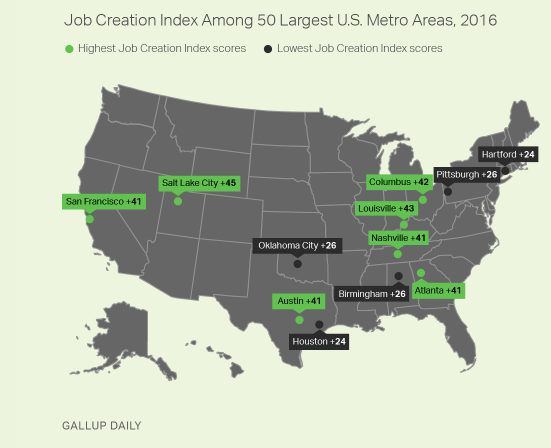Even as Houston continues to grow, its job creation has lagged behind -- way behind. In fact, the Houston metropolitan area fell from leading the nation in job creation in 2012-2013 to dead last in 2016, according to Gallup's Job Creation Index. Houston tied for the last place spot among the top 50 metros with Hartford, Connecticut.
That likely doesn't come as surprise for folks who have been watching the oil slump here locally. But the reversal of fortunes -- which is so stark, and which occurred so quickly -- has been dramatic when measured by new jobs.
The results are based on Gallup surveys that ask workers whether their employers are hiring, keeping a stable workforce, or letting workers go. About 40 percent of Houstonians said their employer is hiring, while 16 percent said their employer is cutting. About 36 percent said their employer's workforce is stable. That gave Houston a net score of +24 percent, tied with Hartford for worst in the nation.
In contrast, Salt Lake City topped the list. It had a net score of +45 percent because 52 percent of residents said their employer was hiring while just 7 percent were seeing layoffs at their place of employment.
"Not only is Houston among the 12 metro areas whose job creation lags the national average," wrote Jeffrey Jones for Gallup, "but it is also one of only two metro areas, along with Oklahoma City, whose score has not improved since 2012-2013. When Houston ranked first for job creation in 2012-2013, its score was +32; now it is +24."
In other words, Houston's setback is occurring at the exact same time other American cities are finally starting to see job improvements after emerging from the recession.
Both Houston and Oklahoma City have large energy sectors, Jones notes, and likely benefitted from high energy costs in the early part of the decade. Houston, Oklahoma City, Hartford, Pittsburgh and Birmingham, Alabama were the five lowest-ranked cities.
But it's worth noting that, "Although these five major metro areas trail most others in job creation, they still have relatively healthy job markets in an absolute sense, with many more workers in those areas reporting job gains than job losses where they work," Gallup wrote.
Nearby, Austin has been in the top five cities for the past three years and joined Salt Lake City, San Francisco and Atlanta, among others, near the top of 2016's list. Though some metro areas hadn't moved much from their relative spots over the years, the report notes that Houston's precipitous drop represents the volatility that the city knows all too well given past oil booms and busts.
As the Houston Chronicle reported in June:
"This downturn was supposed to be different, of course. There's now more than oil supporting Houston's economy, political and business leaders insist: fast-growing hospitals, schools, shopping centers, eateries and arts institutions. And it's true that the region has moved into other industries since the 1980s.
But as the unemployment rate here climbs above the national average, it shows the region's vaunted diversity is more dependent on oil and gas than everyone had hoped."
The latest Gallup report seems to confirm that.



